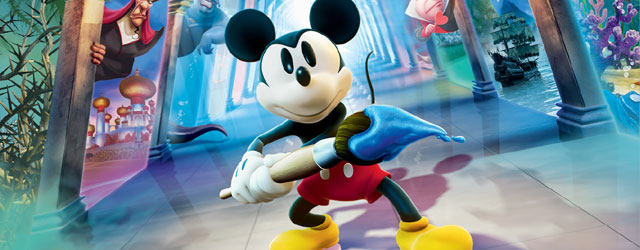[tab:Review]
One of my favorite games on Sega’s Game Gear handheld was 1991’s Castle of Illusion Starring Mickey Mouse, and it stands out in my mind as one of my favorite 2D platformers of that era. As such, I was intrigued by Epic Mickey: Power of Illusion on the 3DS, because it bears such a striking resemblance to the game I remember from my youth. Power of Illusion carries the feel of that classic, while adding the paint theme of the Epic Mickey games. The combination makes for some bumps along the way, without entirely obscuring the great 2D platformer underneath.
The game begins with Mickey lounging on the couch watching TV, when classic Disney character Oswald appears on the screen, explaining that a floating castle has appeared in Toon World. There are lots of toons being held captive in the castle, including Mickey’s beloved Minnie. Mickey immediately sets out to save them, grabbing his magical paintbrush on his way out the door. When he arrives, Oswald explains that the castle is made of illusions, conjured by the evil Mizrabel. Mickey must search the castle for the missing toons in order to stop the villain from taking over Toon World.
The premise is very similar to the original Castle of Illusion game, as are the basic controls. It’s classic platforming, and Mickey runs through levels, jumping on enemies or using his spin attack. The castle is divided into wings, each with several areas to explore. There are loads of Disney characters being held in the castle, and when rescued, they go to the fortress, a safe area in the castle immune to Mizrabel’s powers. Rescued characters grant additional heart power, which opens new areas of the castle for exploration.
While the Illusion roots are clearly present, so is the Epic Mickey influence. In addition to being able to attack foes with his paintbrush, Mickey can use it to alter the world around him. As you move about on the upper screen, the lower screen displays a canvas of the area. Objects that appear on this screen can be painted into the world, or removed from it using thinner. For example, a high ledge can be reached by painting in an elevator platform, or a path opened by erasing a barrier. Manipulation of objects is essential, so you always need to keep an eye on the lower screen to see what you can interact with.
Painting objects is accomplished by tracing their outline on the screen, and you’re graded on how well you do. Better quality objects will work better and last longer, so accurate tracing helps, but paint is plentiful enough that having to re-draw something isn’t a problem. In addition to objects found in the world, you can unlock sketches that can be drawn anywhere in a level when you need a hand. Objects you sketch can grant you some offensive help, produce items or help you reach higher areas, and you can choose which ones to carry before you enter a level.
The platforming in Power of Illusion is excellent, and the title is a lot of fun to play. The controls are tight and responsive, and it feels like retro style with modern precision. It’s challenging though, and if you wind up in a bad situation, you can lose a lot of life quickly. The environmental variables created by the paint mechanic are interesting, but it also makes the game somewhat awkward to play, since you’ll have both hands on the controls, and then suddenly have to pull out the stylus to draw something on the screen. There’s enough drawing and erasing that I found myself constantly picking the stylus up and putting it back down, which broke up the flow of the game.
Rescued toons each have a room in the fortress, and you’ll find that each of them has several side quests for you. Some of them are simple, like drawing an item, and others require you to revisit past areas looking for additional characters or items. Most of the time though, side quests involve running back and forth between the rooms, getting items from one character to deliver them to another. For a game that has such great platforming, putting it on hold to play delivery boy is a drag, and there’s a lot of that to be done. Side quests will earn you upgrades and new sketches though, so they’re not without benefit, even if they are generally tedious.
Epic Mickey: Power of Illusion is hands down one of the best-looking 3DS games I have played. The characters and world are bright and detailed, and character animations are nice and smooth. The 3D is excellent as well, adding some very nice visual accents and depth. Often, the 3D effect in 2D games is negligible, but this is 3D that I kept on the entire time I was playing the game. All of the story and character interactions are text, but there are occasional voice samples. The music is as good as the graphics, and the score fits the mood of the game perfectly. Overall, it’s a very nicely produced package.
Power of Illusion finds its roots in a classic platformer, and its gameplay lives up to that legacy. Unfortunately, the other gameplay elements really break up the action; object manipulation by painting is novel but awkward, and the side quests are just pure filler. Despite those slowdowns, it’s a lot of fun to play. For fans of the original, it’s a walk down memory lane, but it’s also an excellent platformer that stands on its own.
Review copy of game provided by publisher.
[tab:Screenshots]
[tab:END]


